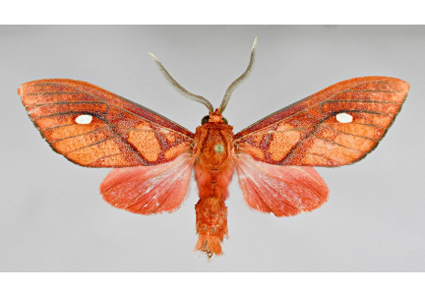Abstract
The genus Ernassa Walker currently consists of five species: Ernassa justina (Stoll), E. sanguinolenta (Cramer), E. ignata Travassos, E. gabrielae Travassos, and E. cruenta (Rothschild). For about 40 years, the genus has been treated with these species. However, a large series of specimens and the study of the characters of the male genitalia, makes evident that the genus is more diverse. Eight new species are described: Ernassa inexplorata sp. nov., E. rufula sp. nov., E. persivalei sp. nov., E. tarisca sp. nov., E. skinnerorum sp. nov., E. harveyi sp. nov., E. markpacei sp. nov. and E. abscondita sp. nov. This work proposes that the species E. cruenta (Rothschild) does not have a common origin with the other species of the genus. At the moment it is treated as incertae sedis.
References
- Cannon, G. (1937) A new biological stain for general purposes. Nature, 139, 549. https://doi.org/10.1038/139549a0
- Cannon, G. (1941) On Chlorazol black E and some other new stains. Journal of the Royal Microscopical Society, 61, 88–95. https://doi.org/10.1111/j.1365-2818.1941.tb00893.x
- Carayon, J. (1969) Emploi du noir chlorazol en anatomie microscopique des insects. Annales de la Société entomologique de France, New Series, 5 (1), 179–193. https://doi.org/10.1080/21686351.1969.12278919
- Common, I.F.B. (1990) Moths of Australia. Melbourne University Press, Melbourne, 535 pp.
- Cramer, P. ([1780]) De Uitlandsche Kapellen voorkomende in de drie Waereld-Deelen Asia, Africa en America. III. Chez S.J. Baalde, Amsterdam, pls. CXCIII–CCLXXXVIII.
- De Waard, J.R., Ivanova, N.V., Hajibabaei, M. & Hebert, P.D.N. (2008) Assembling DNA Barcodes: Analytical Protocols. In: Cristofre, M, ed. Methods in Molecular Biology: Environmental Genetics. Humana Press Inc., Totowa, New Jersey, pp. 275–293. https://doi.org/10.1007/978-1-59745-548-0_15
- Draudt, M. (1916-1919) Familie: Syntomidae. In: Seitz, A. (Ed.), Die Gross-Schmetterlinge der Erde. Vol. 6. A. Kernen, Stuttgart, pp. 33–230.
- Escobar, H. (2018) In a ‘foretold tragedy’ fire consumes Brazil museum. Science, 261 (6506), 960. https://doi.org/10.1126/science.361.6406.960
- Hampson, G. (1898) Catalogue of the Lepidoptera Phalaenae in the British Museum. Vol. I. British Museum (Natural History), London, xxi + 559 pp. https://doi.org/10.5962/bhl.title.52217
- Hampson, G. (1901) Catalogue of the Lepidoptera Phalaenae in the British Museum. Vol. 3. British Museum (Natural History), London, 690 + 23 pp.
- Hampson, G. (1920) Catalogue of the Lepidoptera Phalaenae in the British Museum. Supplement vol. 2. British Museum (Natural History), London, 619 pp.
- Hebert, P.D.N., Cywinska, A., Ball, S.L. & de Waard, J.R. (2003) Biological identifications through DNA barcodes. Proceedings of the Royal Society of London, 270, 313–321. https://doi.org/10.1098/rspb.2002.2218
- Huemer, P., Mutanen, M., Sefc, K.M. & Hebert, P.N. (2014) Testing DNA Barcode Preformance in 1000 Species of European Lewpidoptera: Large Geographic Distances Have Small Genetic Impacts. PLoS ONE, 9 (12), e115774. https://doi.org/10.1371/journal.pone.0115774
- ICZN [International Commission on Zoological Nomenclature] (2000) International code of zoological nomenclature. 4th Edition. Adopted by the International Union of Biological Sciences. International Trust for Zoological Nomenclature, London, 206 pp.
- Klots A.B. (1970) Lepidoptera. In: Tuxen, S.L. (Ed.), Taxonomist’s Glossary of Genitalia in Insects. Munksgaard, Copenhagen, pp. 97–111.
- Kuznetsov N. (1967) Lepidoptera. Fauna of Russia and adjacent countries. Vol. I. Israel program for Scientific Translations, Jerusalem, 305 pp.
- Linnaeus, C. (1758) Systema naturae per regna tria naturae, secundum classes, ordines, genera, species, cum characteribus, differentiis, synonymis, locis. Vol. 1. Editio Decima, reformata. Impensis Direct. Laurentii Salvii, Holmiae, iv + 823 pp. https://doi.org/10.5962/bhl.title.542
- Miller L.D. (1970) Nomenclature of wings veins and cells. Journal of Research on the Lepidoptera, 8 (2), 37–48. https://doi.org/10.5962/p.333547
- Rothschild, W. (1909) Descriptions of some new South American Arctiadae with notes. Noviates Zoologicae, 16 (1), 21–52, pls. IV–VII. https://doi.org/10.5962/bhl.part.21958
- Sibatani A., Ogata, M., Okada, Y. & Okagaki, H. (1954) Male genitalia of Lepidoptera: Morphology and nomenclature. I. Division of the valvae in Rhopalocera, Phalaenidae (=Noctuidae) and Geometridae. Annals of the Entomological Society of America, 47, 93–106. https://doi.org/10.1093/aesa/47.1.93
- Stoll, C. ([1782]) n.k. In: De Uitlandsche Kapellen voorkomende in de drie Waereld-Deelen Asia, Africa en America. IV. Amsterdam, chez S.J. Baalde, pls. CCCLXXIII–CCCC.
- Tamura, K., Stecher, G. & Kumar, S. (2021) MEGA 11: Molecular Evolutionary Genetics Analysis Version 11. Molecular Biology and Evolution, 38 (7), 3022–3027. https://doi.org/10.1093/molbev/msab120
- Travassos, L. (1944) Contribuições ao conhecimento dos “Arctiidae”. I. (Lepidoptera, Heterocera). Revista Brasilera de Biologia, 3 (4), 453–472.
- Travassos, L. (1954) Contribuição ao conhecimento dos “Arctiidae” XXXIV (Lepidoptera, Heterocera). Revista Brasilera de Biologia, 14 (1), 31–44.
- Walker, F. (1856) n.k. In: List of the specimens of Lepidopterous Insects in the Collection of the British Museum. Vol. 7. Printed by order of the Trustees, London, pp. 1509–1808.
- Watson, A. & Goodger, D. (1986) Catalogue of the Neotropical Tiger-moths. Ocassional Papers on Systematic Entomology, 1, 1–71.
- Wootton, R.J. (1979) Function, homology and terminology in insect wings. Systematic Entomology, 4, 81–93. https://doi.org/10.1111/j.1365-3113.1979.tb00614.x
- Zhang, H. & Bu, W. (2022) Exploring Large-Scale Patterns of Genetic Variation in the COI Gene among Insecta: Implications for DNA Barcoding anf Threshold-Based Species Delimitation Studies. Insects, 13 (5), 425. https://doi.org/10.3390/insects13050425


